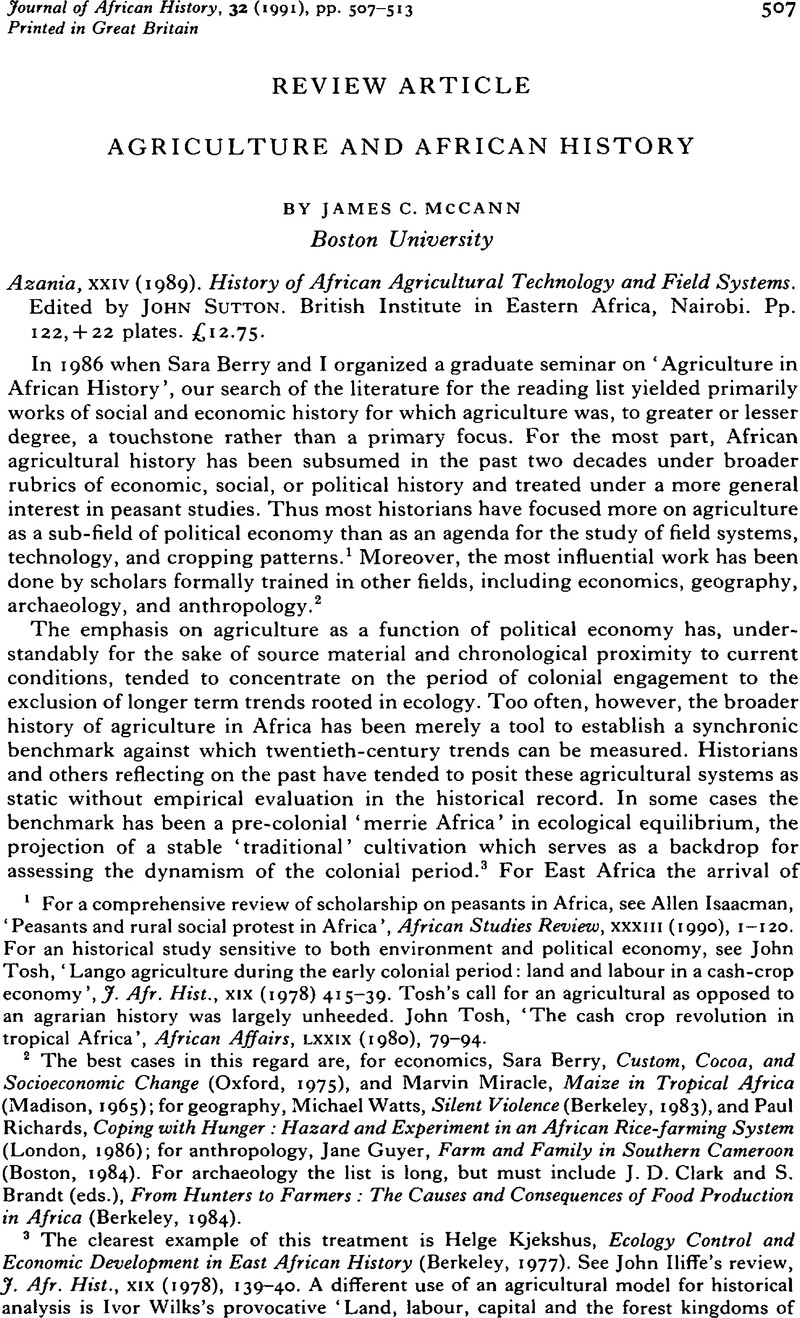Published online by Cambridge University Press: 22 January 2009

1 For a comprehensive review of scholarship on peasants in Africa, see Allen, Isaacman, ‘Peasants and rural social protest in Africa’, African Studies Review, XXXIII (1990), 1–120.Google Scholar For an historical study sensitive to both environment and political economy, see John, Tosh, ‘Lango agriculture during the early colonial period: land and labour in a cash-crop economy’, J. Afr. Hist., XIX (1978) 415–39.Google Scholar Tosh's call for an agricultural as opposed to an agrarian history was largely unheeded. John, Tosh, ‘The cash crop revolution in tropical Africa’, African Affairs, LXXIX (1980), 79–94.Google Scholar
2 The best cases in this regard are, for economics, Sara, Berry, Custom, Cocoa, and Socioeconomic Change (Oxford, 1975)Google Scholar, and Marvin, Miracle, Maize in Tropical Africa (Madison, 1965)Google Scholar; for geography, Michael, Watts, Silent Violence (Berkeley, 1983)Google Scholar, and Paul, Richards, Coping with Hunger: Hazard and Experiment in an African Rice-farming System (London, 1986)Google Scholar; for anthropology, Jane, Guyer, Farm and Family in Southern Cameroon (Boston, 1984).Google Scholar For archaeology the list is long, but must include Clark, J. D. and Brandt, S. (eds.), From Hunters to Farmers: The Causes and Consequences of Food Production in Africa (Berkeley, 1984).Google Scholar
3 The clearest example of this treatment is Kjekshus, Helge, Ecology Control and Economic Development in East African History (Berkeley, 1977).Google Scholar See Iliffe's, John review, J. Afr. Hist., XIX (1978), 139–40.CrossRefGoogle Scholar A different use of an agricultural model for historical analysis is Ivor Wilks's provocative ‘Land, labour, capital and the forest kingdoms of Asante: a model of early change’, in Friedman, J. and Rowlands, M. J. (eds.), The Evolution of Social Systems (London, 1977).Google Scholar
4 For three of the best studies covering this period see Steven, Feierman, The Shambaa Kingdom: A History (Madison, 1974), 120–44Google Scholar; Charles, Ambler, Kenyan Communities in the Age of Imperialism (New Haven, 1988), 68–73, 116Google Scholar; and David, Anderson, ‘Cultivating pastoralists: ecology and economy among the Il Chamus of Baringo, 1840–1980’, in Johnson, D.H. and Anderson, D. M. (eds.), The Ecology of Survival: Case Studies from Northeast African History (London, 1988), 241–60.Google Scholar
5 See Colin, Bundy, The Rise and Fall of the South African Peasantry (London, 1979).Google Scholar A comprehensive examination of the literature on African agrarian response is found in Sara, Berry, ‘The food crisis and agrarian change in Africa: a review essay’, African Studies Review, XXVII (1984), 67–70, 85–9.Google Scholar Berry's survey indicates that historians remained remarkably silent in the debates covered in her sections on ‘Environmental constraints’ and ‘Understanding the forces of agricultural production’.
6 Elias, Mandala, Work and Control in a Peasant Economy: A History of the Lower Tchiri Valley in Malawi 1859–1960 (Madison, 1990), 8–11.Google Scholar
7 Versions of the political argument for famine's root causation vary considerably. For views on colonial policy see Watts, Silent Violence; Megan, Vaughan, The Story of an African Famine: Gender and Famine in Twentieth-Century Malawi (Cambridge, 1987)Google Scholar, and Gregory, Maddox, ‘Ngaa: food storage and famine in Tanzania between the wars’, Int. J. Afr. Hist. Studies, XIX (1986), 17–34.Google Scholar In the non-colonial Ethiopian case, for two divergent views, one historical, one policy oriented, see James, McCann, From Poverty to Famine in Northeast Ethiopia (Philadelphia, 1987)Google Scholar, and Clay, Jason W. and Holcomb, Bonnie K., Politics and the Ethiopian Famine, 1984–1985 (Cambridge, MA, 1985), 5–23.Google Scholar These studies generally use the notion of ‘entitlements’ drawn from Amartya, Sen, Poverty and Famines: An Essay on Entitlements and Deprivation (Oxford, 1981).Google Scholar For an ahistorical, policy-oriented argument see Michael, Lofchie, ‘The decline of African agriculture: an internalist perspective’, in Glantz, Michael (ed.), Drought and Hunger in Africa: Denying Famine a Future (Cambridge, 1987).Google Scholar
8 Sutton, J. E. G., ‘Irrigation and soil conservation in African agricultural history: with a reconsideration of the Inyanga terracing (Zimbabwe) and Engaruka irrigation works (Tanzania)’, J. Afr. Hist., XXV (1984), 25–41CrossRefGoogle Scholar; Clark and Brandt, From Hunters to Farmers.
9 Christopher, Ehret, ‘On the antiquity of agriculture in Ethiopia’, J. Afr. Hist., XX (1979). 161–78.Google Scholar See also Fage, J. D. and Oliver, Roland (eds.), Papers in African Prehistory (Cambridge, 1970).Google Scholar Sutton (p. 8, n. 7) points also to work in historical linguistics by Gerard Phillipson of Paris and David Schoenbrun of the University of Georgia.
10 J. E. G. Sutton, ‘Editor's introduction: Fields, farming, and history in Africa’, 6. Indeed, there is a fine line between identifying a past process of change leading to current conditions, and an evolutionary model. For the former see McCann, James C., ‘A great agrarian cycle? Productivity in Highland Ethiopia, 1900 to 1987’, J. Interdisciplinary Hist., XX (1990), 389–416.CrossRefGoogle Scholar
11 See Ladurie, Emmanuel Leroy, Times of Feast, Times of Famine: A History of Climate since the Year 1000 (Garden City, 1971), 23–79.Google Scholar
12 He had made this point in greater depth in Sutton, ‘Irrigation and soil conservation’.
13 For an additional argument on this point see McCann, James C., ‘A dura revolution and frontier agriculture in northwest Ethiopia, 1898–1920’, J. Afr. Hist., XXXI (1990), 121–34.CrossRefGoogle Scholar
14 A superb synthesis of the political economy historiographic tradition, with sensitivity towards the ecological and agricultural context of production, is presented by Elias Mandala, Work and Control. For an ahistorical, synchronic environmental model see Blaikie, Piers, ‘Environment and access to resources in Africa’, Africa, LIX (1989), 18–40.CrossRefGoogle Scholar
15 Most prominent in this area is the work of young historians of East Africa, such as James Giblin and Jamie Monson, in which the history of social institutions and resource management is rooted in both field work and an appreciation for the exigencies of epidemiology and crop science. See Giblin, ‘Trypanosomiasis control in African history: an evaded issue?’ J. Afr. Hist., XXXI (1990), 59–80CrossRefGoogle Scholar, and Jamie Monson, ‘How the “Squeeze” began: ecology control and the sustainability of agricultural systems in the inner Kilombero Valley of Tanzania, 1840–1890’ (paper presented at the African Studies Association meeting, Baltimore, 1990).